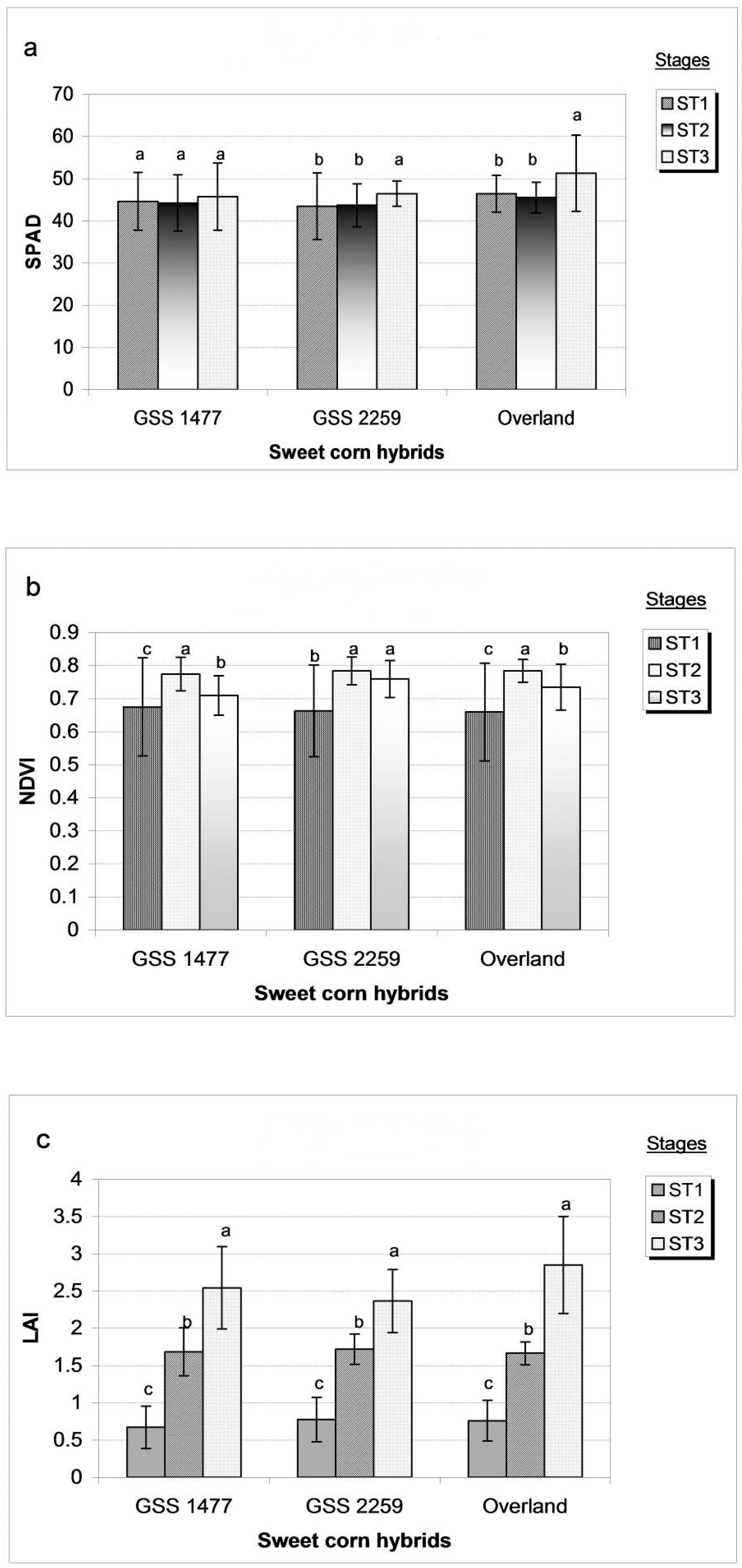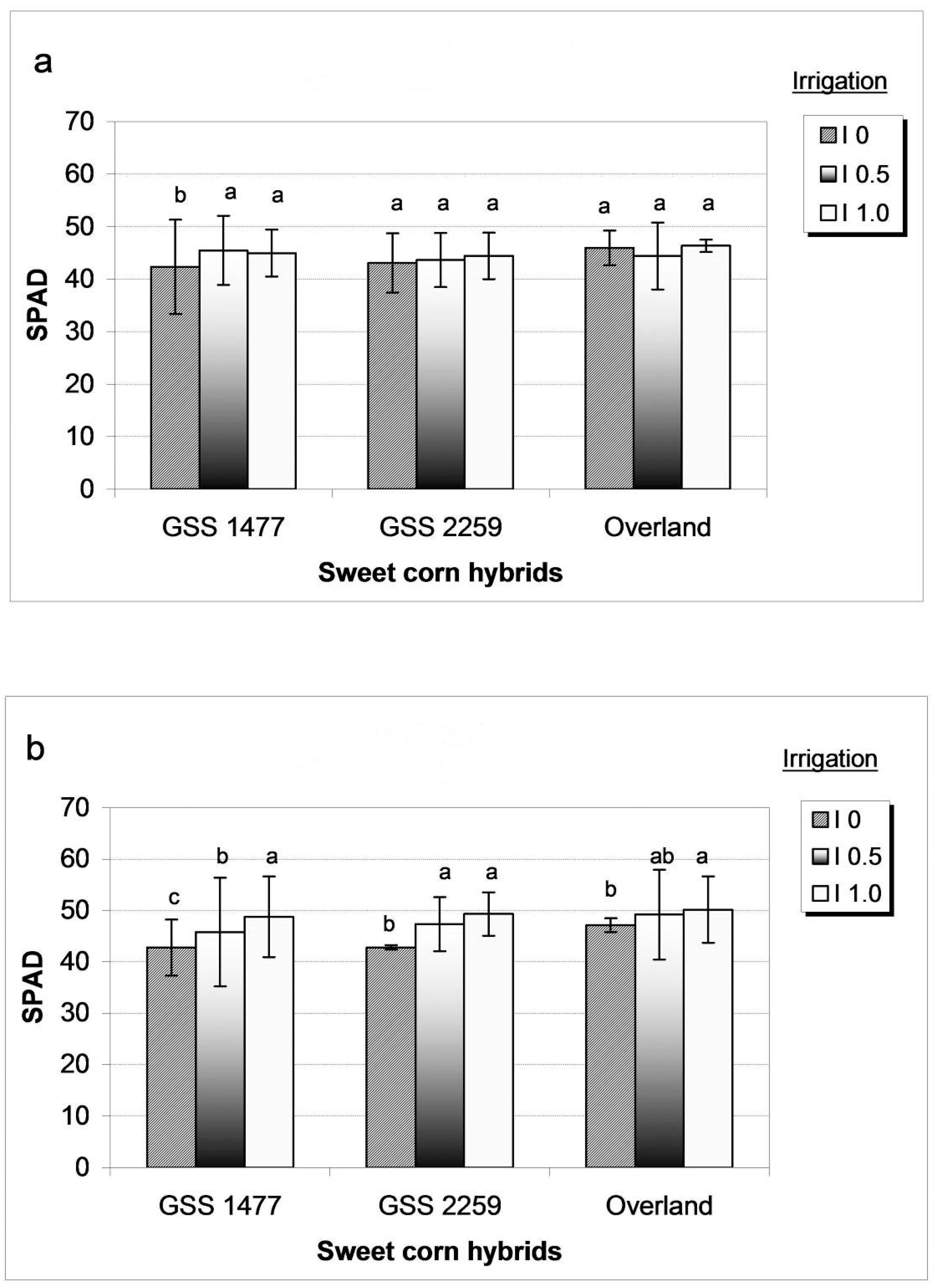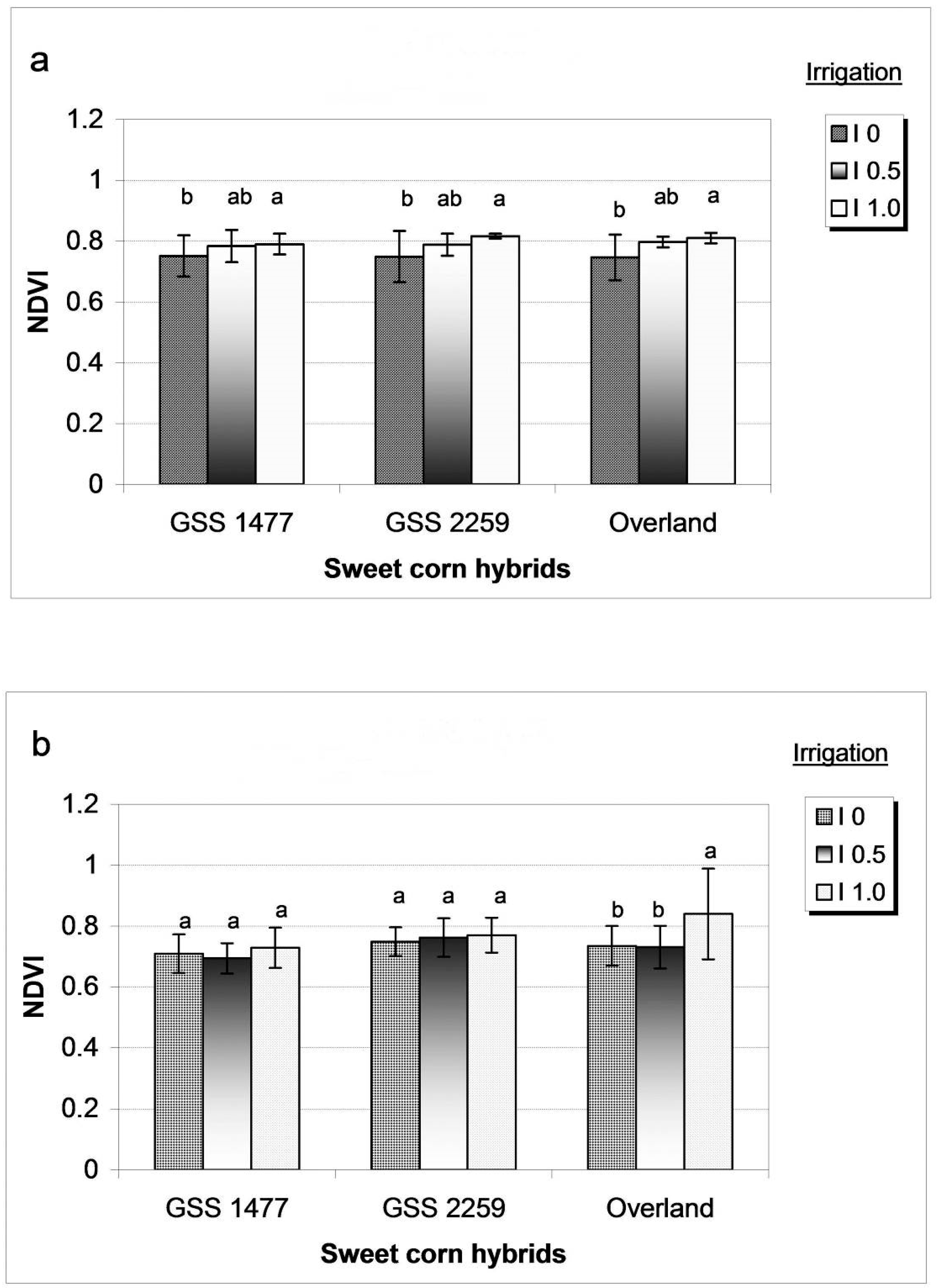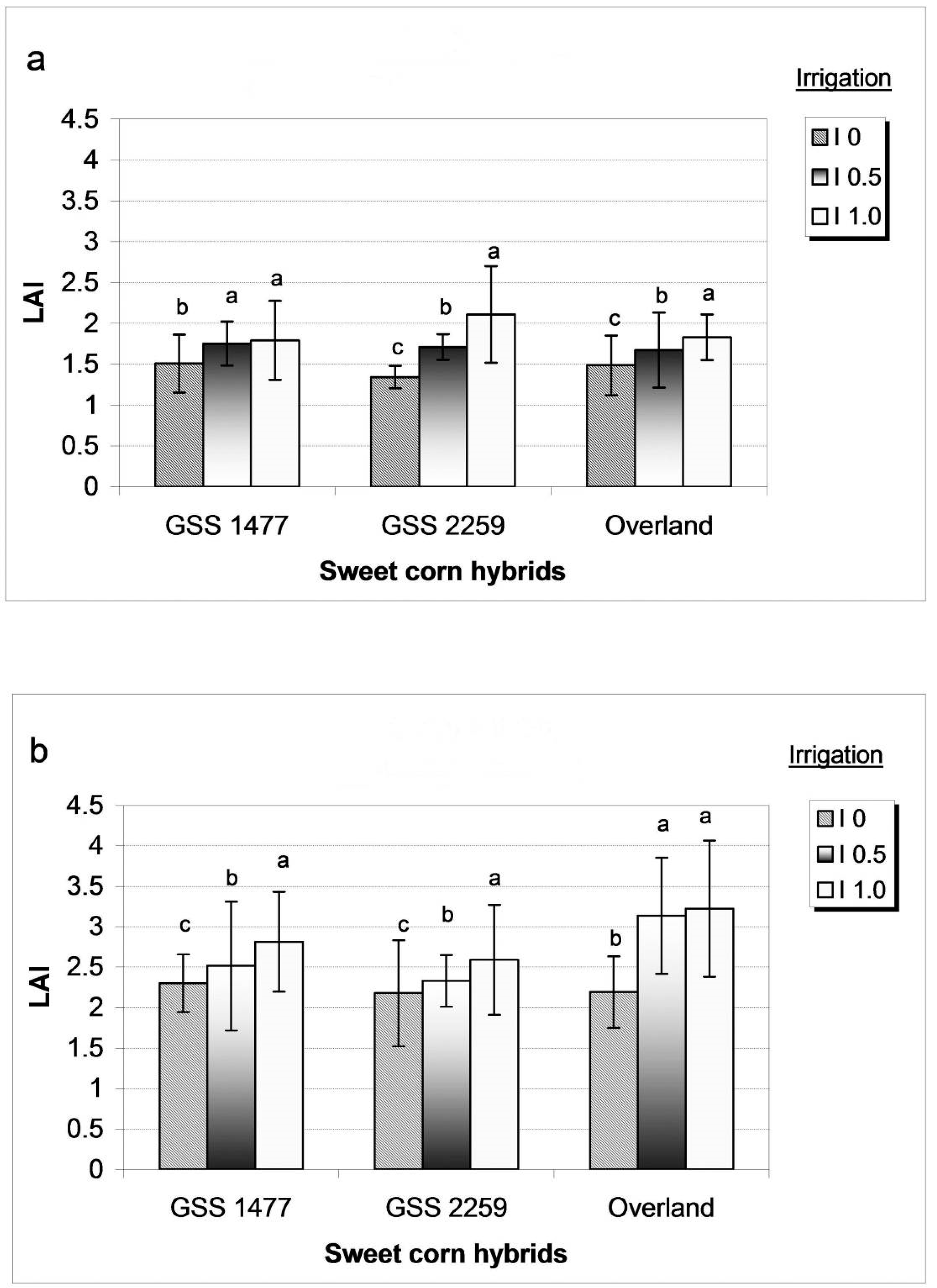Effect of Water Supply on Spectral Traits and Their Relationship with the Productivity of Sweet Corns
Abstract
1. Introduction
2. Materials and Methods
2.1. Experimental Conditions
2.2. Measurement of Traits
2.3. Measurement of Yield
2.4. Chemical Analysis
2.5. Statistical Analysis
3. Results
3.1. Effect of Water Supply on Spectral Traits, Yield Quality and Quality
3.2. Relationship between Spectral Traits and Yield
3.3. Relationship between Spectral Trait and Yield Quality
4. Discussion
5. Conclusions
Author Contributions
Funding
Acknowledgments
Conflicts of Interest
References
- Kang, S.; Shi, W.; Zhang, J. An improved water-use efficiency for maize grown under regulated deficit irrigation. Field Crop. Res. 2000, 67, 207–214. [Google Scholar] [CrossRef]
- Megyes, A.; Rátonyi, T.; Huzsvai, L.; Szabó, G.; Dobos, A.; Sum, O. A műtrágyázás hatása a Dekalb 471 SC kukoricahibrid (Zea mays L.) termésére öntözés nélküli és öntözéses kezelésben. [Effect of fertilizer on yield of Dekalb 471 SC maize hybrid (Zea mays L.) under non-irrigated and irrigated conditions]. Növénytermelés 2000, 49, 307–316. [Google Scholar]
- Lejeune, P.; Bernier, G. Effect of environment on the early steps of ear initiation in maize (Zea mays L.). Plant Cell Environ. 1996, 19, 217–224. [Google Scholar] [CrossRef]
- Claassen, M.M.; Shaw, R.H. Water deficit effects on corn. II. Grain components. Agron. J. 1970, 62, 652–655. [Google Scholar] [CrossRef]
- Edmeades, G.O.; Bolaños, J.; Chapman, S.C.; Lafitte, H.R.; Bänziger, M. Selection improves drought tolerance in tropical maize populations. I. Gains in biomass, grain yield, harvest index. Crop. Sci. 1999, 39, 1306–1315. [Google Scholar] [CrossRef]
- Azanza, F.; Klein, B.P.; Juvik, J.A. Sensory characterization of sweet corn lines differing in physical and chemical composition. J. Food Sci. 1996, 61, 253–257. [Google Scholar] [CrossRef]
- Szymanek, M.; Tanas, W.; Kassar, H.F. Kernel carbohydrates concentration in sugary-1, sugary enhanced and shrunken sweet corn kernels. Agric. Agric. Sci. Procedia 2015, 7, 260–264. [Google Scholar] [CrossRef]
- Douglass, S.K.; Juvik, J.A.; Splittstoesser, W.E. Sweet corn seedling emergence and variation in kernel carbohydrate reserves. Seed Sci. Technol. 1993, 21, 433–436. [Google Scholar]
- Barmeier, G.; Hofer, K.; Schmidhalter, U. Mid-season prediction of grain yield and protein content of spring barley cultivars using high-throughput spectral sensing. Eur. J. Agron. 2017, 90, 108–116. [Google Scholar] [CrossRef]
- Zhou, J.; Khot, L.R.; Boydston, R.A.; Miklas, P.N.; Porter, L. Low altitude remote sensing technologies for crop stress monitoring: A case study on spatial and temporal monitoring of irrigated pinto bean. Precis. Agric. 2018, 19, 555–569. [Google Scholar] [CrossRef]
- Blackburn, G.A. Hyperspectral remote sensing of plant pigments. J. Exp. Bot. 2007, 58, 855–867. [Google Scholar] [CrossRef] [PubMed]
- Carter, G.A.; Knap, A.K. Leaf optical properties in higher plants: Linking spectral characteristics to stress and chlorophyll concentration. Am. J. Bot. 2001, 88, 677–684. [Google Scholar] [CrossRef] [PubMed]
- Carvalho, R.F.; Takaki, M.; Azevedo, R.A. Plant pigments: The many faces of light perception. Acta Physiol. Plant. 2001, 33, 241–248. [Google Scholar] [CrossRef]
- Fanizza, G.; Ricciardi, L.; Bagnulo, C. Leaf greenness measurements to evaluate water stressed genotypes in Vitis vinifera. Euphytica 1991, 55, 27–31. [Google Scholar] [CrossRef]
- Zhao, J.; Sun, H.; Dai, H.; Zhang, G.; Wu, F. Difference in response to drought stress among Tibet wild barley genotypes. Euphytica 2010, 172, 395–403. [Google Scholar] [CrossRef]
- Nemeskéri, E.; Molnár, K.; Víg, R.; Nagy, J.; Dobos, A. Relationships between stomatal behaviour, spectral traits and water use and productivity of green peas (Pisum sativum L.) in dry seasons. Acta Physiol. Plant. 2015, 37, 1–16. [Google Scholar] [CrossRef]
- Nemeskéri, E.; Kovács-Nagy, E.; Sárdi, É. Relationships between the biochemical and spectral traits of leaves and the productivity of apple trees in organic and integrated production systems. Biol. Agric. Hortic. 2017, 33, 97–114. [Google Scholar] [CrossRef]
- Stone, P.J.; Wilson, D.R.; Jamieson, P.D.; Gillespie, R.N. Water deficit effects on sweet corn. Part II. Canopy development. Aust. J. Agric. Res. 2001, 54, 115–126. [Google Scholar] [CrossRef]
- Genc, L.; Inalpulat, M.; Kizil, U.; Mirik, M.; Smith, S.E.; Mendes, M. Determination of water stress with spectral reflectance on sweet corn (Zea mays L.) using classification tree (CT) analysis. Zemdirbyste 2013, 100, 81–90. [Google Scholar] [CrossRef]
- Spitkó, T.; Nagy, Z.; Zsubori, Z.T.; Szőke, C.; Berzy, T.; Pintér, J.; Marton, C.L. Connection between normalized difference vegetation index and yield in maize. Plant Soil Environ. 2016, 62, 293–298. [Google Scholar] [CrossRef]
- Romano, G.; Zia, S.; Spreer, W.; Sanchez, C.; Cairns, J.; Araus, J.L.; Muler, J. Use of thermography for high throughtput phenotyping of tropical maize adaptation in water stress. Comput. Electron. Agric. 2011, 79, 67–74. [Google Scholar] [CrossRef]
- Bell, G.E.; Howell, B.M.; Johnson, G.V.; Raun, W.R.; Solie, J.B.; Stone, M.L. Optical sensing of turfgrass chlorophyll content and tissue nitrogen. HortScience 2004, 39, 1130–1132. [Google Scholar]
- Monteiro, P.F.C.; Filho, R.A.; Xavier, A.C.; Monteiro, R.O.C. Assessing biophysical variable parameters of bean crop with hyperspectral measurements. Sci. Agric. 2012, 69, 87–94. [Google Scholar] [CrossRef]
- Nemeskéri, E.; Molnár, K.; Helyes, L. Relationships of spectral traits with yield and nutritional quality of snap beans (Phaseolus vulgaris L.) in dry seasons. Arch. Agron. Soil Sci. 2018, 64, 1222–1239. [Google Scholar] [CrossRef]
- Weber, V.; Araus, J.L.; Cairns, J.E.; Sanchez, C.; Melchinger, A.E.; Orsini, E. Prediction of grain yield using reflectance spectra of canopy and leaves in maize plants grown under different water regimes. Field Crop. Res. 2012, 128, 82–90. [Google Scholar] [CrossRef]
- Ali, A.M.; Thinda, H.S.; Sharmaa, S.; Varinderpal-Singha. Prediction of dry direct-seeded rice yields using chlorophyll meter, leaf color chart and GreenSeeker optical sensor in northwestern India. Field Crop. Res. 2014, 161, 11–15. [Google Scholar] [CrossRef]
- Magney, T.S.; Eitel, J.U.H.; Huggins, D.R.; Vierling, L.A. Proximal NDVI derived phenology improves in-season predictions of wheat quantity and quality. Agric. For. Meteorol. 2016, 217, 46–60. [Google Scholar] [CrossRef]
- Shuttleworth, J.W.; Wallace, J.S. Evaporation from sparse crops—An energy combination theory. Q. J. R. Meteorol. Soc. 1985, 3, 839–855. [Google Scholar] [CrossRef]
- Allen, R.G.; Pereira, L.S.; Raes, D.; Smith, M. Crop evapotranspiration. In Guidelines for Computing Crop Water Requirements; FAO Irrigation and Drainage; Paper No. 56; FAO: Rome, Italy, 1998. [Google Scholar]
- Rouse, J.W.; Haas, R.H.; Schell, J.A.; Deering, D.W. Monitoring vegetation systems in the Great Plains with ERTS. In Third Earth Resources Technology Satellite-1 Symposium; National Aeronautics and Space Administration: Washington, DC, USA, 1973; pp. 309–317. [Google Scholar]
- Shreve, B.; Thiex, N.; Wolf, M. NFTA Reference Methods; National Forage Testing Association (NFTA): Omaha, NE, USA, 2006. [Google Scholar]
- Determination of sugar: Luff-Schoorl method, method 11:1-GaFTA. Available online: https://www.gafta.com/ write/MediaUploads/Contracts/2014/method_10.1_2014. Pdf (accessed on 31 January 2019).
- Nemeskéri, E. Breeding strategy for improvement of colour quality and carotenoid levels in dry pea seeds. Commun. Biometry Crop. Sci. Agrobiol. 2006, 1, 49–55. [Google Scholar]
- Fischer, K.S.; Palmer, F.E. Tropical Maize. In The Physiology of Tropical Field Crops; Goldsworthy, P.R., Fischer, N.M., Eds.; Wiley: New York, NY, USA, 1984; pp. 213–248. [Google Scholar]
- Chiuta, N.E.; Mutengwa, C.S. Response of yellow quality protein maize inbred lines to drought stress at seedling stage. Agronomy 2018, 8, 287. [Google Scholar] [CrossRef]
- Nemeskéri, E.; Molnár, K.; Dobos, A.C.S. Csemegekukorica (Zea mays L. convar. saccharata) sztóma működése, és hatása a növekedésre és terméskomponensekre eltérő vízellátás alatt [Stomatal behaviour and its influence on the growing and yield components of sweet corn (Zea mays L. convar. saccharata]. Növénytermelés 2017, 66, 75–95. [Google Scholar]
- Rivera-Hernández, B.; Carrillo-Ávila, E.; Obrador-Olán, J.J.; Juárez-López, J.F.; Aceves-Navarro, L.A. Morphological quality of sweet corn (Zea mays L.) ears as response to soil moisture tension and phosphate fertilization in Campeche, Mexico. Agric. Water Manag. 2010, 97, 1365–1374. [Google Scholar] [CrossRef]
- Aydinsakir, K.; Erdal, S.; Buyuktas, D.; Bastug, R.; Toker, R. The influence of regular deficit irrigation applications on water use, yield, and quality components of two corn (Zea mays L.) genotypes. Agric. Water Manag. 2013, 128, 65–71. [Google Scholar] [CrossRef]
- Zhao, D.; Reddy, K.R.; Kakani, V.G.; Read, J.J.; Koti, S. Canopy reflectance in cotton for growth assessment and lint yield prediction. Eur. J. Agron. 2007, 26, 335–344. [Google Scholar] [CrossRef]
- Ertek, A.; Kara, B. Yield and quality of sweet corn under deficit irrigation. Agric. Water Manag. 2013, 129, 138–144. [Google Scholar] [CrossRef]
- Ványiné-Széles, A.; Nagy, J. Effects of nutrition and water supply on the yield and grain protein content of maize hybrids. Aust. J. Crop. Sci. 2012, 6, 381–390. [Google Scholar]
- Xue, L.H.; Cao, W.X.; Yang, L.Z. Predicting grain yield and protein content in winter wheat at different N supply levels using canopy reflectance spectra. Pedosphere 2007, 17, 646–653. [Google Scholar] [CrossRef]





| Traits | Water Supply †† | 2011 | 2012 | 2013 |
|---|---|---|---|---|
| SPAD | I1.0 | - | 50.47 a | 44.50 b |
| I0.5 | - | 50.43 a | 40.74 b ** | |
| I0 | - | 47.49 a ** | 41.85 b ** | |
| NDVI | I1.0 | 0.716 c | 0.741 b | 0.773 a |
| I0.5 | 0.695 b | 0.750 a | 0.741 a ** | |
| I0 | 0.654 b ** | 0.733 a ** | 0.745 a ** | |
| LAI | I1.0 | 2.18 a | 1.68 c | 1.77 bc |
| I0.5 | 1.93 a | 1.71 b | 1.50 c † | |
| I0 | 1.44 b * | 1.61 a | 1.51 b † | |
| Height (cm) | I1.0 | 241.94 b | 253.26 a | 227.13 b |
| I0.5 | 225.42 b ** | 239.07 a ** | 214.67 b * | |
| I0 | 191.69 a ** | 199.42 a ** | 201.77 a * | |
| Ears no. plant−1 I | I1.0 | 1.10 a | 1.08 a | 1.13 a |
| I0.5 | 1.11 a | 1.02 a | 1.13 a | |
| I0 | 1.00 ab ** | 1.03 a | 1.03 a | |
| Ears no. plant−1 II | I1.0 | 1.00 a | 0.38 c | 0.56 b |
| I0.5 | 1.00 a | 0.21 c | 0.49 b * | |
| I0 | 1.00 a | 0.17 c* | 0.43 b * | |
| Husked Ear weight | I1.0 | 305.61 b | 332.25 a | 325.46 a |
| g plant−1 | I0.5 | 307.18 b | 340.21 a | 307.23 b * |
| I0 | 274.34 b ** | 301.61 a * | 302.02 a * | |
| Number of kernels | I1.0 | 723.61 b | 766.97 a | 801.44 a |
| per ear | I0.5 | 737.33 b | 785.30 a | 789.01 a |
| I0 | 681.20 c * | 779.29 ab | 753.67 b * |
| Traits | Water Supply †† | 2011 | 2012 | 2013 |
|---|---|---|---|---|
| Ear length (cm) | I1.0 | 25.66 a | 24.09 b | 23.07 b |
| I0.5 | 25.13 a | 23.72 b | 22.62 b | |
| I0 | 23.61 a ** | 23.58 a | 21.25 b ** | |
| Ear diameter (cm) | I1.0 | 4.95 a | 5.08 a | 5.04 a |
| I0.5 | 4.95 a | 5.14 a | 4.97 a | |
| I0 | 4.73 b ** | 4.82 b * | 5.02 a | |
| No. of kernels per ear row | I1.0 | 39.07 b | 43.27 a | 43.68 a |
| I0.5 | 39.58 b | 44.38 a | 42.44 a | |
| I0 | 40.29 b † | 43.47 a | 40.89 b * | |
| No. of kernel rows per ear | I1.0 | 18.56 a | 17.76 a | 18.34 a |
| I0.5 | 18.69 a | 17.76 b | 18.63 a | |
| I0 | 16.93 b ** | 18.02 a | 18.44 a | |
| DMC% | I1.0 | 22.57 a | 22.00 ab | 20.86 b |
| I0.5 | 22.33 a | 22.50 a | 22.62 a * | |
| I0 | 23.00 b † | 22.97 b † | 24.81 a * | |
| Sugar w/w% | I1.0 | 9.84 a | 7.47 b | 7.60 b |
| I0.5 | 9.27 a | 6.78 b | 9.12 a ** | |
| I0 | 10.15 a | 6.44 c | 10.10 a ** | |
| Carotene mg kg−1 | I1.0 | 0.255 b | 0.227 b | 0.317 a |
| I0.5 | 0.210 b ** | 0.217 b | 0.311 a | |
| I0 | 0.197 b ** | 0.207 b ** | 0.281 a ** |
| Traits | Stage †† | NDVI | LAI | Plant Height cm | Ear Length cm | Ear Diameter cm | Husked Ear Weight g plant−1 | Yield t ha−1 |
|---|---|---|---|---|---|---|---|---|
| SPAD | ST2 | 0.8310 *** | 0.4762 | 0.4598 | −0.6021 ** | 0.3233 | 0.4951 | 0.4614 |
| ST3 | 0.2036 | 0.4991 | 0.3510 | 0.2744 | 0.2260 | 0.3436 | 0.3323 | |
| NDVI | ST2 | - | 0.7435 * | 0.1626 | 0.5157 | 0.5575 | 0.6804 | 0.4619 |
| ST3 | - | 0.4617 | 0.3539 | −0.5094 | 0.2989 | 0.5697 | −0.6837 * | |
| LAI | ST2 | - | 0.5755 | 0.4464 | 0.6182 | 0.7134 | 0.1729 | |
| ST3 | - | 0.5677 | 0.8423 ** | 0.7351 † | 0.7982 * | 0.5117 |
| Traits | Stage †† | NDVI | LAI | Plant Height cm | Ear Length cm | Ear Diameter cm | Husked Ear Weight g plant−1 | Yield t ha−1 |
|---|---|---|---|---|---|---|---|---|
| SPAD | ST2 | 0.7411*** | 0.3010 | 0.2246 | −0.4933 * | 0.6233 * | 0.6150 * | −0.6250 ** |
| ST3 | 0.2662 | 0.777 4*** | 0.3239 | −0.5614 * | 0.4880 * | −0.6014 ** | −0.7507 *** | |
| NDVI | ST2 | - | 0.0506 | 0.3177 | 0.1056 | 0.9159 ** | 0.7648 * | 0.4907 |
| ST3 | - | −0.4402 | 0.4876 | −0.6378 † | 0.3345 | 0.6789 | −0.4412 | |
| LAI | ST2 | - | 0.6457 | −0.6511 † | 0.2315 | 0.1154 | 0.8068 * | |
| ST3 | - | 0.4789 | 0.6856 | 0.3406 | 0.3596 | 0.6328 † |
| I0 | I0.5 | ||||||
|---|---|---|---|---|---|---|---|
| Traits | Stage †† | Dry Matter % | Sugar w/w% | Total Carotenoids mg kg−1 | Dry Matter % | Sugar w/w% | Total Carotenoids mg kg−1 |
| SPAD | ST2 | 0.2335 | 0.7638 * | 0.7304 | 0.2119 | −0.8232 ** | 0.8055 * |
| ST3 | 0.4249 | 0.4931 | 0.4816 | 0.1626 | 0.7018 * | 0.7094 | |
| NDVI | ST2 | 0.7116 | 0.8957 ** | 0.8156 * | −0.1821 | 0.7972 * | 0.4305 |
| ST3 | 0.4190 | 0.3622 | 0.7005 * | 0.8301 * | 0.0991 | 0.5179 | |
| LAI | ST2 | 0.3457 | 0.4885 | 0.3853 | 0.2802 | 0.5821 | 0.7317 * |
| ST3 | 0.5437 | 0.8401 * | 0.9212 ** | 0.2347 | −0.0677 | 0.7095 * | |
| Hybrid | Water Supply †† | SPAD | NDVI | LAI | Plant Height cm | Ear Length cm | Ear Diameter cm | Husked Ear Weight g plant−1 | Yield t ha−1 | Biomass t ha−1 | Kernel z | ||
|---|---|---|---|---|---|---|---|---|---|---|---|---|---|
| DMC % | Sugar w/w% | Carotenoids mg kg−1 | |||||||||||
| GSS 1477 | I1.0 | 46.63 b | 0.73 ab | 1.78 | 244.50 c | 26.64 a | 4.86 b | 304.67 a | 27.64 a | 45.51 b | 22.54 b | 9.16 | 0.24 |
| I0.5 | 44.46 c | 0.72 c | 1.61 | 216.70 e | 26.00 a | 4.78 c | 318.55 a | 24.67 b | 43.77 b | 22.75 ab | 8.65 | 0.24 | |
| I0 | 43.00 d | 0.71 c | 1.59 | 177.72 g | 24.10 c | 4.71 c | 286.98 b | 21.02 c | 29.21 c | 23.58 a | 8.82 | 0.22 | |
| GSS 2259 | I1.0 | 46.23 b | 0.75 a | 1.84 | 260.27 a | 25.41 b | 4.97 b | 315.39 a | 30.49 a | 57.74 a | 22.17 b | 8.24 | 0.28 |
| I0.5 | 44.67 c | 0.74 a | 1.62 | 252.36 b | 25.09 b | 4.99 b | 302.77 a | 25.40 b | 54.56 a | 22.35 b | 7.95 | 0.26 | |
| I0 | 43.37 cd | 0.72 c | 1.48 | 227.23 d | 22.39 d | 4.79 c | 277.81 b | 22.56 c | 40.04 b | 22.80 b | 8.36 | 0.24 | |
| Overland | I1.0 | 48.30 a | 0.74 a | 1.97 | 220.19 e | 24.19 c | 5.10 a | 308.32 a | 22.35 c | 49.11 a | 20.71c | 7.50 | 0.27 |
| I0.5 | 45.55 b | 0.73 b | 1.85 | 207.93 f | 23.65 c | 5.14 a | 307.26 a | 22.17 c | 44.67 b | 22.35 b | 8.57 | 0.24 | |
| I0 | 46.43 b | 0.71 c | 1.56 | 174.54 g | 23.50 c | 4.80 c | 271.98 b | 19.00 d | 30.33 c | 24.40 a | 9.51 | 0.22 | |
© 2019 by the authors. Licensee MDPI, Basel, Switzerland. This article is an open access article distributed under the terms and conditions of the Creative Commons Attribution (CC BY) license (http://creativecommons.org/licenses/by/4.0/).
Share and Cite
Nemeskéri, E.; Molnár, K.; Rácz, C.; Dobos, A.C.; Helyes, L. Effect of Water Supply on Spectral Traits and Their Relationship with the Productivity of Sweet Corns. Agronomy 2019, 9, 63. https://doi.org/10.3390/agronomy9020063
Nemeskéri E, Molnár K, Rácz C, Dobos AC, Helyes L. Effect of Water Supply on Spectral Traits and Their Relationship with the Productivity of Sweet Corns. Agronomy. 2019; 9(2):63. https://doi.org/10.3390/agronomy9020063
Chicago/Turabian StyleNemeskéri, Eszter, Krisztina Molnár, Csaba Rácz, Attila Csaba Dobos, and Lajos Helyes. 2019. "Effect of Water Supply on Spectral Traits and Their Relationship with the Productivity of Sweet Corns" Agronomy 9, no. 2: 63. https://doi.org/10.3390/agronomy9020063
APA StyleNemeskéri, E., Molnár, K., Rácz, C., Dobos, A. C., & Helyes, L. (2019). Effect of Water Supply on Spectral Traits and Their Relationship with the Productivity of Sweet Corns. Agronomy, 9(2), 63. https://doi.org/10.3390/agronomy9020063





